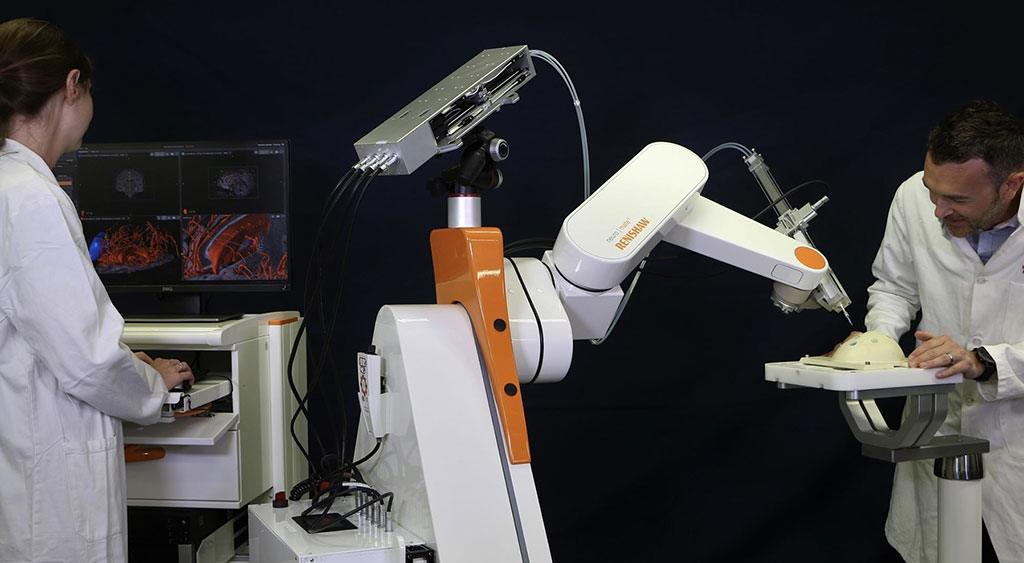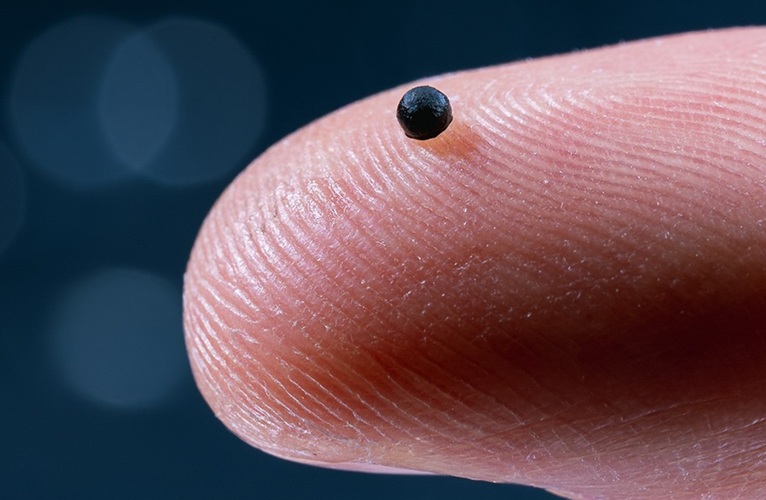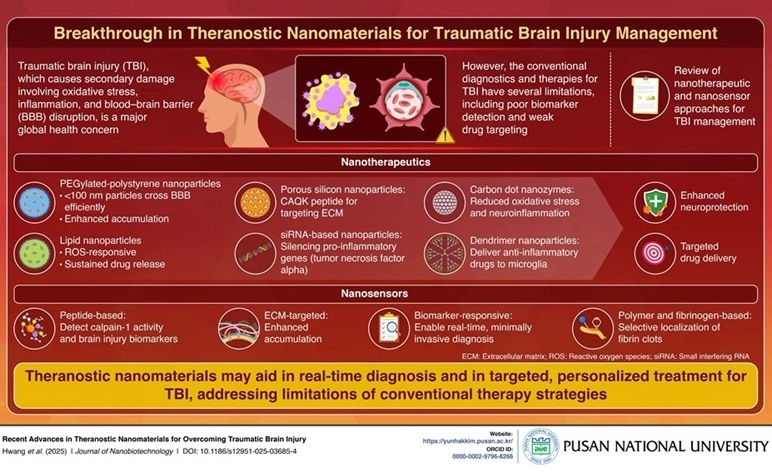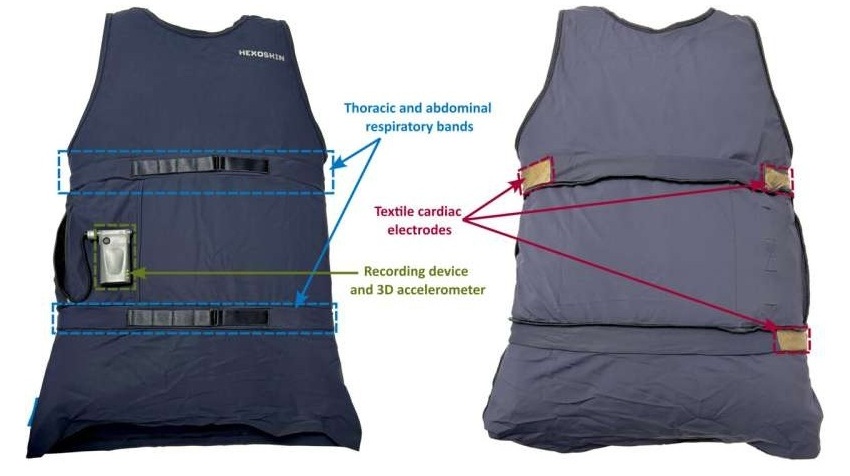Minimally Invasive Robot Places Flexible, Steerable Catheter in Live Brain
|
By HospiMedica International staff writers Posted on 24 Oct 2022 |

While performing minimally invasive surgery on the brain, surgeons use deeply penetrating catheters to diagnose and treat disease. However, currently used catheters are rigid and difficult to place precisely without the aid of robotic navigational tools. The inflexibility of the catheters combined with the intricate, delicate structure of the brain means catheters can be difficult to place precisely, which brings risks to this type of surgery. Now, scientists have successfully placed a bioinspired steerable catheter into the brain of an animal for the first time. The early-stage research tested the delivery and safety of the new implantable catheter design in two sheep to determine its potential for use in diagnosing and treating diseases in the brain. If proven effective and safe for use in people, the platform could simplify and reduce the risks associated with diagnosing and treating disease in the deep, delicate recesses of the brain. It could help surgeons to see deeper into the brain to diagnose disease, deliver treatment like drugs and laser ablation more precisely to tumors, and better deploy electrodes for deep brain stimulation in conditions such as Parkinson’s and epilepsy.
The platform developed by scientists at Imperial College London (London, UK) improves on existing minimally invasive, or 'keyhole', surgery, where surgeons deploy tiny cameras and catheters through small incisions in the body. It includes a soft, flexible catheter to avoid damaging brain tissue while delivering treatment, and an artificial intelligence (AI)-enabled robotic arm to help surgeons navigate the catheter through brain tissue. Inspired by the organs used by parasitic wasps to stealthily lay eggs in tree, bark, the catheter consists of four interlocking segments that slide over one another to allow for flexible navigation.
It connects to a robotic platform that combines human input and machine learning to carefully steer the catheter to the disease site. Surgeons then deliver optical fibers via the catheter so they can see and navigate the tip along brain tissue via joystick control. The AI platform learns from the surgeon’s input and contact forces within brain tissues to guide the catheter with pinpoint accuracy. Compared to traditional ‘open’ surgical techniques, the new approach could eventually help to reduce tissue damage during surgery, and improve patient recovery times and length of post-operative hospital stays.
To test their platform, the researchers deployed the catheter in the brains of two live sheep which were given pain relief and monitored for 24 hours a day over a week for signs of pain or distress before being euthanized so that researchers could examine the structural impact of the catheter on brain tissue. They found no signs of suffering, tissue damage, or infection following catheter implantation.
“Our new precise, minimally invasive platform improves on currently available technology and could enhance our ability to safely and effectively diagnose and treat diseases in people, if proven to be safe and effective,” said senior author Professor Ferdinando Rodriguez y Baena, of Imperial’s Department of Mechanical Engineering.
“Our findings could have major implications for minimally invasive, robotically delivered brain surgery,” added lead author Dr. Riccardo Secoli, also from Imperial’s Department of Mechanical Engineering. “We hope it will help to improve the safety and effectiveness of current neurosurgical procedures where precise deployment of treatment and diagnostic systems is required, for instance in the context of localized gene therapy.”
Related Links:
Imperial College London
Latest Surgical Techniques News
- New Study Findings Could Halve Number of Stent Procedures
- Breakthrough Surgical Device Redefines Hip Arthroscopy
- Automated System Enables Real-Time "Molecular Pathology" During Cancer Surgery
- Groundbreaking Procedure Combines New Treatments for Liver Tumors
- Ablation Reduces Stroke Risk Associated with Atrial Fibrillation
- Optical Tracking Method Identifies Target Areas in Robot-Assisted Neurosurgery
- General Anesthesia Improves Post-Surgery Outcomes for Acute Stroke Patients
- Drug-Coated Balloons Can Replace Stents Even in Larger Coronary Arteries
- Magnetic Kidney Stone Retrieval Device Outperforms Ureteroscopic Laser Lithotripsy
- Absorbable Skull Device Could Replace Traditional Metal Implants Used After Brain Surgery
- Magic Silicone Liquid Powered Robots Perform MIS in Narrow Cavities
- 'Lab-on-a-Scalpel' Provides Real-Time Surgical Insights for POC Diagnostics in OR
- Biodegradable Brain Implant Prevents Glioblastoma Recurrence
- Tiny 3D Printer Reconstructs Tissues During Vocal Cord Surgery
- Minimally Invasive Procedure for Aortic Valve Disease Has Similar Outcomes as Surgery
- Safer Hip Implant Design Prevents Early Femoral Fractures
Channels
Critical Care
view channel
Magnetically Guided Microrobots to Enable Targeted Drug Delivery
Stroke affects 12 million people globally each year, often causing death or lasting disability. Current treatment relies on systemic administration of clot-dissolving drugs, which circulate throughout... Read more
Smart Nanomaterials Detect and Treat Traumatic Brain Injuries Simultaneously
Traumatic brain injury (TBI) continues to leave millions with long-term disabilities every year. After a sudden impact from a fall, collision, or accident, the brain undergoes inflammation, oxidative stress,... Read more
Earlier Blood Transfusion Could Reduce Heart Failure and Arrhythmia in Heart Disease Patients
Blood loss during or after surgery can place significant stress on people with heart disease, increasing the risk of dangerous complications. Transfusions are often delayed until hemoglobin levels fall... Read morePatient Care
view channel
Revolutionary Automatic IV-Line Flushing Device to Enhance Infusion Care
More than 80% of in-hospital patients receive intravenous (IV) therapy. Every dose of IV medicine delivered in a small volume (<250 mL) infusion bag should be followed by subsequent flushing to ensure... Read more
VR Training Tool Combats Contamination of Portable Medical Equipment
Healthcare-associated infections (HAIs) impact one in every 31 patients, cause nearly 100,000 deaths each year, and cost USD 28.4 billion in direct medical expenses. Notably, up to 75% of these infections... Read more
Portable Biosensor Platform to Reduce Hospital-Acquired Infections
Approximately 4 million patients in the European Union acquire healthcare-associated infections (HAIs) or nosocomial infections each year, with around 37,000 deaths directly resulting from these infections,... Read moreFirst-Of-Its-Kind Portable Germicidal Light Technology Disinfects High-Touch Clinical Surfaces in Seconds
Reducing healthcare-acquired infections (HAIs) remains a pressing issue within global healthcare systems. In the United States alone, 1.7 million patients contract HAIs annually, leading to approximately... Read moreHealth IT
view channel
EMR-Based Tool Predicts Graft Failure After Kidney Transplant
Kidney transplantation offers patients with end-stage kidney disease longer survival and better quality of life than dialysis, yet graft failure remains a major challenge. Although a successful transplant... Read more
Printable Molecule-Selective Nanoparticles Enable Mass Production of Wearable Biosensors
The future of medicine is likely to focus on the personalization of healthcare—understanding exactly what an individual requires and delivering the appropriate combination of nutrients, metabolites, and... Read moreBusiness
view channel
Philips and Masimo Partner to Advance Patient Monitoring Measurement Technologies
Royal Philips (Amsterdam, Netherlands) and Masimo (Irvine, California, USA) have renewed their multi-year strategic collaboration, combining Philips’ expertise in patient monitoring with Masimo’s noninvasive... Read more
B. Braun Acquires Digital Microsurgery Company True Digital Surgery
The high-end microsurgery market in neurosurgery, spine, and ENT is undergoing a significant transformation. Traditional analog microscopes are giving way to digital exoscopes, which provide improved visualization,... Read more
CMEF 2025 to Promote Holistic and High-Quality Development of Medical and Health Industry
The 92nd China International Medical Equipment Fair (CMEF 2025) Autumn Exhibition is scheduled to be held from September 26 to 29 at the China Import and Export Fair Complex (Canton Fair Complex) in Guangzhou.... Read more














